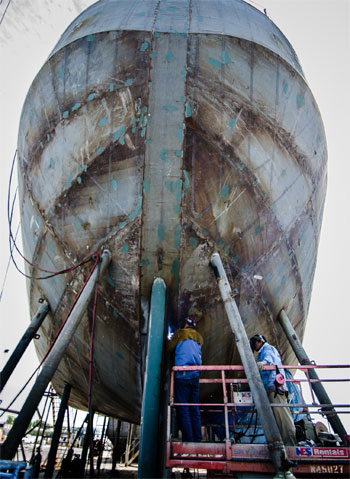Signet Maritime chose Arcturus and Polaris, two beacons of reference for celestial navigators dating from ancient times, as the names of the Houston-based company’s two new ASD tugboats under construction at Patti Marine Enterprises in Pensacola, Fla.
The star Arcturus is in the constellation Boötes and follows Ursa Major around the pole. The name derives from the Greek word Arkto, for bear or guardian of the bear, which is also the root of the word arctic.
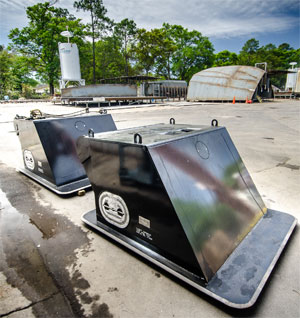 |
|
The Smith Berger towing pins. |
Signet Arcturus, the tug, follows Signet Constellation, Signet Stars & Stripes and Signet Weatherly, in an impressive string of ASD tugs joining the Signet fleet, all from the drawing board at Robert Allan Ltd. since 2011. Arcturus is expected to be delivered in December.
Polaris, also known as the North Star, is the brightest star in the constellation Ursa Minor. Signet Polaris, the tug, is scheduled for delivery in March 2014. Both vessels will be working out of Signet’s International Operations Center at Ingleside, on Corpus Christi Bay, Texas.
Signet’s Arcturus and Polaris are based on the 105-foot Signet Weatherly, a RAmparts 3200 class of z-drive tug built at Signet Shipbuilding & Repair in Pascagoula, Miss., and based at Signet’s Ingleside operations center.
“These boats are structurally similar to the Weatherly, except they are much more powerful.” said Joe Dahl, general manager for Signet Shipbuilding & Repair. Dahl usually works at the Pascagoula yard, but is spending the majority of his time overseeing the construction at the Patti yard.
“We wanted to go offshore with the new boats so the engine rooms are bigger, for bigger engines and more bollard pull,” said Dahl. “They also have a larger skeg than the Weatherly, because we increased bollard pull from 61 to 83 metric tons and employ CPP (controllable pitch propeller) design for high stress maneuvering. We wanted a boat that could tow offshore, do ship assist and escort work, do LNG ships, and do rig moves. A multi-mission boat.”
“This boat is one of our RAmparts 3200-W designs,” said Robert Allan. “But as is typical in each of our projects, we customize the boat to suit our client’s specific needs. In this case one of the main drivers was the need for a very large fuel capacity, 90,000 gals in a 32-meter tug (105 feet). Hence the hull became a little deeper and wider than the standard design. The tug was also configured to maximize effectiveness of both the towing and escorting operations.”
Dahl is no stranger to Robert Allan Ltd. tug designs. His first two for Signet, America and Pacific Star, were delivered in 2008 and are leased to Foss Maritime. Another Robert Allan tug, Signet Magic, is under construction at the Signet yard in Pascagoula. Dahl has Allen Cox, Signet’s manager of new construction, leading on that boat, which is due out in August. With the delivery of Polaris, Dahl will have 10 ASD tugs designed by the Vancouver naval architect’s firm on his resume, if at this point, he needs one.
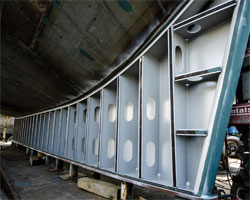 |
|
The large skeg of Arcturus will help it perform high-stress maneuvers such as ship escort work. |
“To achieve all of those goals, we needed a big bow for a hawser winch to do ship assist work, and a big towing winch for ocean towing and rig moves,” said Dahl. “We needed a big bow fender and FiFi-1 for LNG work. And we needed submarine fenders in lieu of a bilge keel to allow us to get alongside of a rig and be protected from all of the steel that you can’t see because it’s underwater.”
For power, Arcturus has two Caterpillar C175-16 Tier 3 mains with Rolls-Royce US 255 CPP azimuthing stern drives. The total horsepower is 6,834 and the speed is expected to be 12.5 knots. The bollard pull is expected to test at 83 metric tons. The 105-foot length corresponds to Weatherly, but the horsepower and bollard pull are similar to Constellation and Stars & Stripes, delivered to Signet from Trinity Offshore last year.
 |
As bollard pull becomes, arguably, more and more the benchmark of a tug’s marketability, the heft and durability of the hawser winch are on the ascendant when it comes to designing and equipping a modern tug.
Arcturus and Polaris will have a Markey DEPCF-52S 75-hp electric hawser winch on the bow, with 500 feet of 9-inch-circumference Samson Saturn-12 line. For towing, each tug will have a Markey TESD 34, double-drum, 100-hp electric towing winch, with 2,500 feet of 2.25-inch wire on one drum and 1,500 feet of 2.25-inch wire on the other.
According to Scott Kreis, VP sales at Markey Machinery in Seattle, configuring the hawser winch on the bow of a tug requires a round robin of communication between the winch manufacturer, the naval architect, the vessel owner and the shipyard.
Kreis explained that the two line angles of critical interest are the extreme limits of the line running through the staple to the winch’s level wind, both in plan view and elevation view. Of most interest are the lines depicting the angles when the level wind is at its extreme to one side or the other. “That angle is evaluated against the strength of our level wind and its ability to react to the resulting loads,” said Kreis.
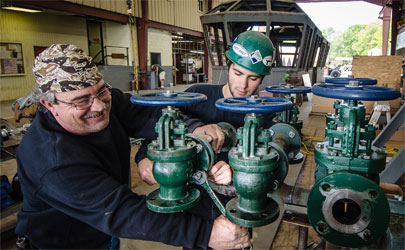 |
|
Pipefitters Brian Rosenmarkly and Frank Patti III work on the bilge pumps of Arcturus. Patti is a member of the third generation of his family to be employed at the shipyard in Pensacola, Fla. |
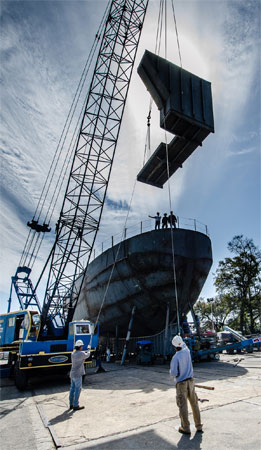 |
|
Installing the stairwell mezzanine for Arcturus. The vessel is designed for many missions, including offshore towing, ship assist and escort, LNG and rig moves. |
The elevation view shows the vertical angle of the line as it relates to the bow arrangement of the staple and the winch level wind.
Kreis explained that it is important that the line run clearly from the staple onto the level wind and that there be a clear sweep from full drum to empty drum. If the line doesn’t clear cleanly, it can cause undue abrasion to the line.
“I can tell you with regard to the Arcturus and Polaris at Patti, that that study resulted in something unusual and interesting because it was a legacy winch design,” said Kreis. The winch, in relation to the staple and with consideration of the bow bulwarks, presented a vertical angle problem. “The level wind from full drum to barrel layer indicated that the winch be positioned on the deck on an angled foundation. That solution isn’t out of the question, but instead, following a meeting with the shipyard and Joe Dahl, we found that the bulwark could be lowered to solve the problem.”
The solution had to be cleared with Robert Allan Ltd. to make sure the fix met all ABS requirements, and as a result the bulwarks were lowered by a minimum certifiable amount. “Then we were able to readjust the staple down, which allowed us to come to a satisfactory line lead to avoid any kind of interference between the line and the level wind,” said Kreis.
Kreis went on to explain that the process is conducted on every boat contract to make sure the customer gets the most out of the life of the winch and out of the soft line on the drum. “If we’re not fine-tuning these things for instance, you might have a condition where the line is rubbing on the upper portion of the level wind, chafing the upper layers of the line,” he said. “For ship assist and docking, you can be on a very short high lead configuration every day.”
Finishing off the stern of Arcturus and Polaris in style are Smith Berger towing pins. “They’re the Cadillac of towing pins,” said Dahl.
Schuyler Rubber’s Broussard, La., facility supplied the fendering for the new tugs, shipping M fendering for the bow and 52 feet of 32-inch cylindrical bow bulwark fenders for each boat. The submarine fendering mentioned by Dahl is the D-Obore normally used for submarine handling and applied along the bow above and below waterline and the side shell. The lower bow and stem are covered with laminated fendering.
A high bollard pull and FiFi-1 firefighting are prerequisites to satisfy LNG clients in today’s market. With 83 tons of bollard pull, the new tugs have the power to satisfy that market sector’s thirst. As for firefighting, they are classified FiFi-1, with full deluge and 2.6-inch fireproof glass in all the pilothouse windows. Each boat has two FFS SFP 250×350 pumps driven by a power takeoff from the front main engines, pumping up to 5,300 gpm at a 400-foot range, utilizing FFS monitors on the aft bridge deck.
The future helmsmen aboard Arcturus and Polaris will not have to rely on those bright beacons in the night sky to guide them. The pilothouse console is arrayed with a passel of JRC electronics that includes two JMA-5312-6 radars, JLR-21 GPS compass, JHS-183 AIS and JRC VHF and SSB radios.

